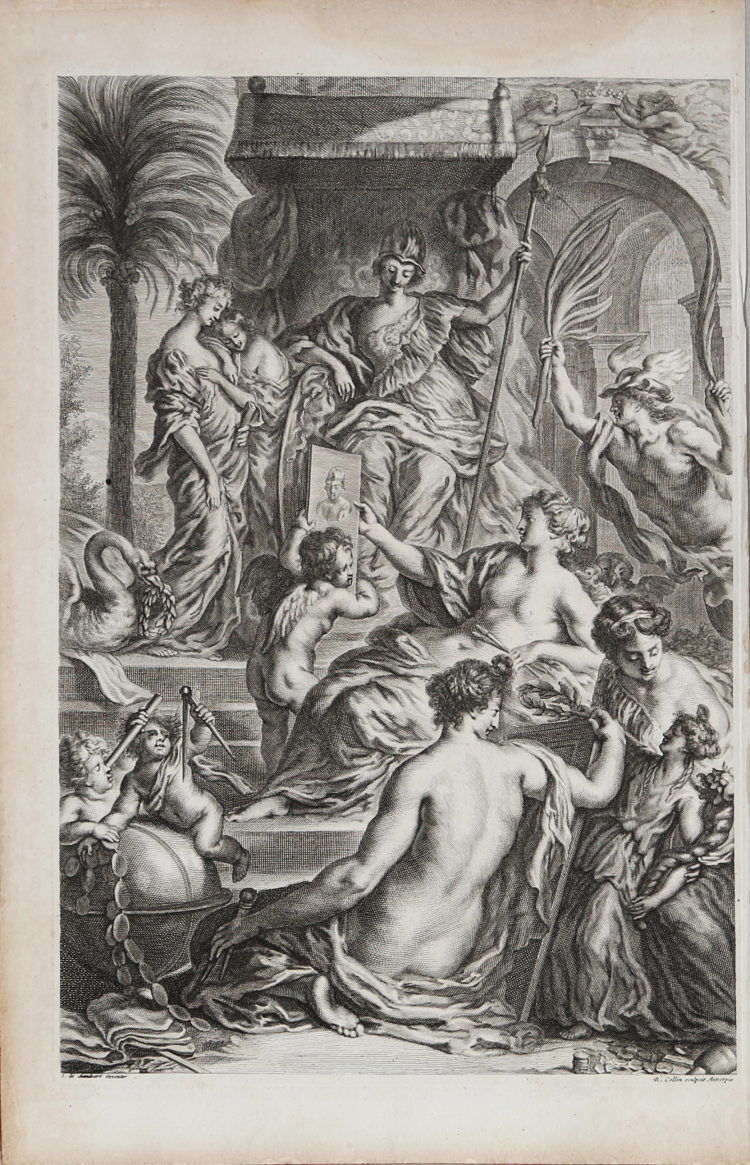



| Reference: | S21764 |
| Author | Richard COLLIN |
| Year: | 1676 |
| Measures: | 228 x 335 mm |


| Reference: | S21764 |
| Author | Richard COLLIN |
| Year: | 1676 |
| Measures: | 228 x 335 mm |
Minerva sits on her throne in the Olymp. To her left is Poetry with a swan, to her right Mercury comes walking toward Minerva with palm branches. On the steps of Minerva's throne, Painting, Sculpture and Architecture are working.
Etching with engraving 1676, after Joachim von Sandrart. Signed in lower margin: "I. de Sandrart inventor." and "R. Collin sculpit Antverpia". Title page for: Joachim von Sandrart, L'Academia Todesca della Architectura Scultura e Pittura oder Teutsche Academie der Edlen Bau.
Richard Collin (1626, Luxembourg – 1698, Brussels), was an engraver; a pupil of Joachim von Sandrart in Rome, and became a master in the Antwerp Guild of St. Luke in 1650–1651. He worked in Rome and in Antwerp, and is known for portraits he engraved for Cornelis de Bie's book of artists called Het Gulden Cabinet. In the 1660s he took on pupils, and in 1678 he moved to Brussels and became the court engraver for Charles II of Spain.
Plate taken fom the monumental Academia Todesca della Architectura, Scultura & Pittura: oder Teutsche Academie der Edlen Bau, Bild-und Mahlerey-Künste (Deutsche Academy of Architecture - Sculpture – Painting).
The first edition, in German, was published by Joachim von Sandrart in Nuremberg, in three volumes respectively in 1675, 1679 and 1680.
For the plates Sandrart used his students as and many others artist as Karl Gustav von Amling (1650-1703); Philip Kilian (1628-1693); Richard Collin (1627-97); Georg Andreas Wolfgang (1631-1716); Johann Georg Waldreich (d.1680); Melchior Küsel (1626-1683); Franck, Johann (fl.1659-1690); George Christoph Eimmart (1638-1705); Susanna Maria von Sandrart (1658-1716); Bartholomäus Kilian (1630-1696).
The work is full of illustrations of ancient and modern Roman buildings, sculpture, the theory of painting, biographies of artists, including German and contemporary (ie seventeenth-century) artists, and antiquities. The work is dedicated to the world-renowned German nation and to champions and lovers of art ('Der Welt-berühmten Teutschen Nation ... Kunst-Helden und Kunstliebenden').
References
National Gallery (Washington), Mark J. Millard, III (1998), no. 111; F.W. H. Hollstein, German engravings ... ca. 1400-1700 (1954-), 38-41; Anna Schreurs, Unter Minerva schutz: bildung durch kunst in Joachim von Sandrarts 'Teutscher Academie' (2012).
Richard COLLIN (1626, Lussemburgo - 1698, Bruxelles)
|
Richard Collin was an engraver; a pupil of Joachim von Sandrart in Rome, and became a master in the Antwerp Guild of St. Luke in 1650–1651. He worked in Rome and in Antwerp, and is known for portraits he engraved for Cornelis de Bie's book of artists called Het Gulden Cabinet. In the 1660s he took on pupils, and in 1678 he moved to Brussels and became the court engraver for Charles II of Spain.
|
Richard COLLIN (1626, Lussemburgo - 1698, Bruxelles)
|
Richard Collin was an engraver; a pupil of Joachim von Sandrart in Rome, and became a master in the Antwerp Guild of St. Luke in 1650–1651. He worked in Rome and in Antwerp, and is known for portraits he engraved for Cornelis de Bie's book of artists called Het Gulden Cabinet. In the 1660s he took on pupils, and in 1678 he moved to Brussels and became the court engraver for Charles II of Spain.
|